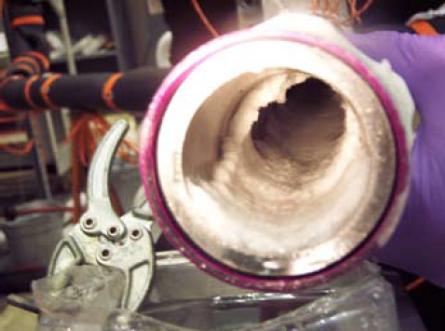Rolls-Royce is developing a modification for the fuel-oil heat exchanger on Trent 800 after investigators managed to replicate the icing-induced constriction suspected of causing last year's British Airways Boeing 777-200 crash at London Heathrow.
In an update on the inquiry the Air Accidents Investigation Branch (AAIB) is also recommending that US and European authorities study the feasibility of using anti-icing additives in commercial aircraft fuel.
While accumulation of released ice on the fuel-oil heat exchanger - leading to a restriction of fuel flow to the engines - had been identified as the likely reason for the loss of thrust on the BA 777, investigators had not previously determined the mechanism for the icing process.
But the AAIB states today that Boeing has conducted further testing by reassembling most of the fuel-delivery system from the right wing of the crashed aircraft.
The tests examined fuel flow, for various long durations, at temperatures of 5°C, minus 12°C, minus 20°C and minus 34°C.
Through these tests the investigators have shown, with "reasonable repeatability", that a layer of ice can accumulate inside the fuel-delivery pipes, greater than the quantities needed to block the heat exchanger if flushed downstream.
 |
|---|
© Air Accidents Investigation Branch |
Ice tended to adhere at temperatures of minus 5°C to minus 20°C, with the ice becoming "most sticky" at about minus 12°C. There was little accumulation at the coldest temperature.
"The ice deposits were found to be a mixture of water and fuel and were soft and 'mobile' as opposed to a hard glazing of ice," says the AAIB.
It has devised a "most likely" scenario for the BA 777 event. At a relatively low fuel flow, ice would start forming inside the fuel feed pipes passing through the main wing fuel tank while the centre tank was supplying fuel to the engines.
The temperature of the fuel in the 777's main tanks would have been around minus 21°C, and cooled over the subsequent five hours of cruise. But ice is likely to have built up in the warmer environment of the fuel feed pipes in the engine pylon.
In the later stages of the approach, says the AAIB, a combination of engine acceleration, turbulence, pitch changes and temperature variations could have led to a sudden release of soft ice in both engines, which travelled downstream to block the heat exchanger and cause the engines to lose thrust.
Based on the available information, the AAIB has recommended that Boeing and Rolls-Royce jointly review the 777's engine fuel system and develop changes which prevent ice restricting fuel flow at the heat exchanger.
It states that both manufacturers have accepted this recommendation and that Rolls-Royce has developed a modification to the exchanger: "The modification will improve the [exchanger's] capability in the event of a fuel system ice-release event."
Owing to limitations in the available data, says the AAIB, the investigation cannot "totally eliminate" the possibility of an ice-related fuel restriction elsewhere in the fuel system. But it says that it has not identified any features in the system which would have caused a large enough concentration of ice to cause such a restriction.
Source: Flight International


























